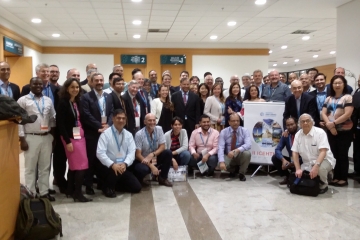Tom Judd
IFMBE CED: A Federation of global Clinical Engineering (CE) national societies …a resource for Clinical and Biomedical Engineers around the globe, continually growing, see http://cedglobal.org/ and the new CED website at http://ced.ifmbe.org/.
History of IFMBE: Let’s go deeper; the International Federation for Medical and Biological Engineering (IFMBE) – begun in 1959 – today has 120,000 members worldwide, and 59 affiliated organizations. CED (the Clinical Engineering Division) is one of two specialties within this wider Biomedical Engineering (BME) Federation, the other the Health Technology Assessment Division (HTAD).
History of CED: The history of CED’s global work began in 1979. CED’s modern era began in 2009 under the leadership of CED Board Chair Dr. Yadin David (USA), and continuing until 2018 with leadership by Dr. Saide Calil (Brazil) and Dr. Ernesto Iadanza (Italy). I had the privilege of being elected to Board Chair in June 2018 for a term of three years until 2021. Today, CED has interaction with Health Technology (HT) colleagues from 180 countries, and its Board and Collaborators includes over 100 CE/BME/HT practitioners from 40 countries.
CED and the World Health Organization (WHO): CED’s partnership with WHO began in the late 1980s and continues to this day, formally as IFMBE is an endorsed NGO of WHO. In 2007, the partnership gathered momentum via WHO’s Resolution on Health Technologies (wherein Health Technology (HT) is defined ‘as the application of organized knowledge and skills in the form of (medical) devices, medicines, vaccines, procedures and systems developed to solve a health problem and improve quality of life.’) The Resolution: “recognizes that HT (whose main component is medical devices) equips health-care providers with tools that are indispensable for effective and efficient prevention, diagnosis, treatment and rehabilitation and attainment of internationally agreed health-related development goals, including those contained in the Millennium Declaration.”
CE-HTM Definitions and Impact: WHO noted in 2018 that it is critical that “trained and qualified BME professionals are required to design, evaluate, regulate, maintain and manage medical devices, and train on their safe use in health systems around the world.” And that “this area is often referred to as clinical engineering (CE) or health-care technology management (HTM).” In 2017-2018, WHO conducted surveys of CE-HTM professionals, and found over 800,000 practitioners reported globally. CED has created a video outlining who CEs are and what they do, see this 3-minute video. In summary: HT must be managed to ensure full clinical benefit and expected financial return on investment. A CED study, with links provided, shows 400 case studies from 125 countries where management of medical devices made a positive difference over the years 2007-2018. This CE Success Story project was developed by the CED and published in the Global CE Journal in its inaugural issue in October 2018.
Global CE Day and Global CE Summits: IFMBE CED also began celebrating Global CE Day (GCED) on October 21, 2015, that has become an annual event rippling around the world focused on recognition of the many contributions CEs make every day. In 2016, GCED held programs in 20 countries and had 70,000 Social Media hits; in 2018, GCED expanded to events in over 40 countries and had 320,000 Social Media touches! A summary of 2018 Global CE Day was captured in this 7-minute video. GCED originated at CED’s 1st International CE-HTM Congress in China in 2015 where CED held its 1st Global Summit, with a 2nd Congress and Summit held in Brazil in 2017. The 3rd Congress and Summit are planned in Rome in October 2019, where we continue to build global CE consensus and launch priority projects, aligned with international health leaders and the wider public.
What’s happening with CED in 2019: (1) CED – in coordination with WHO – plans to partner with our global HT colleagues to take the collection of these evidence-based CE Success Stories to Ministry of Health leaders in 180 countries. The Success Story case studies have six categories – including Access, Innovation, Health Systems, Management, e-Technology and Quality & Safety – and together demonstrate potential solutions to many healthcare challenges in individual countries and around the world. And (2) join us in our 12 projects focused on global CE Recognition, Capacity Building, and Professional Exchange.

